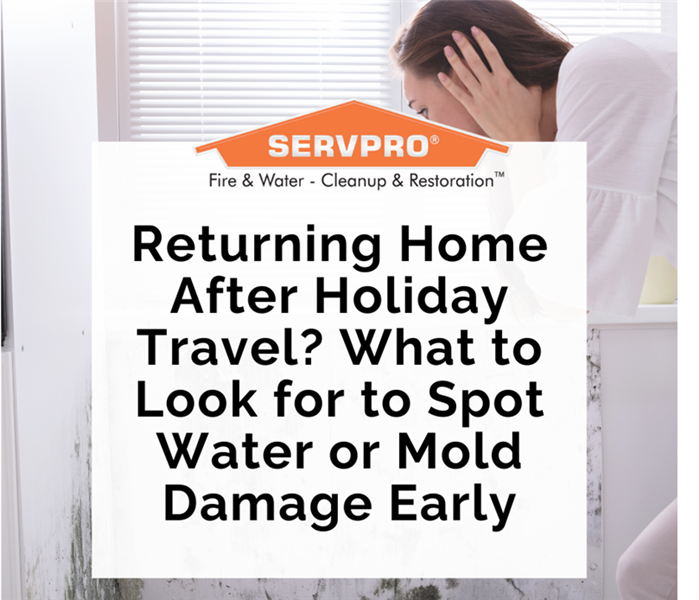Returning Home After Holiday Travel? Here's How to Spot Water or Mold Damage Early
11/25/2024 (Permalink)
 At SERVPRO of Norwood/West Roxbury, our team is trained to handle water and mold damage restoration efficiently.
At SERVPRO of Norwood/West Roxbury, our team is trained to handle water and mold damage restoration efficiently.
Coming home after a refreshing holiday should be a relief, not a headache. Unfortunately, issues like water or mold damage can arise while you're away, potentially turning your homecoming into a stressful situation. Acting quickly to identify and address these problems can save you from costly repairs and health risks. Follow this guide to inspect your home for water or mold damage upon your return.
1. Begin with a Walkthrough
Before unpacking, take a stroll through your home and trust your senses. Pay attention to any musty odors, which could signal hidden mold or water damage. Focus on areas prone to dampness, such as the basement, bathrooms, kitchen, and laundry room.
2. Look for Water Stains or Discoloration
Scan walls, ceilings, and floors for new stains, discoloration, or bubbling paint. These visible clues often indicate water damage, possibly from a hidden leak. Catching these early can help prevent mold from spreading.
3. Inspect Windows and Doors
Check window and door frames for condensation, water stains, or warped wood. Foggy or dripping windows may point to leaks or excess humidity that could lead to mold growth.
4. Check Under Sinks and Around Plumbing
Inspect areas beneath sinks, around toilets, and near exposed pipes for standing water or dampness. Even small leaks can escalate, causing structural damage and increasing mold risks.
5. Examine Appliances
Appliances like dishwashers, refrigerators, and washing machines can leak, especially when unused for a while. Look for water pooling or mold spots around them. Musty odors are another red flag for hidden water damage.
6. Check the Attic and Basement
The attic and basement are common trouble spots for water and mold damage. Look for signs of roof leaks in the attic, such as wet insulation or darkened wood. In the basement, watch for standing water, damp walls, or mold on surfaces.
7. Inspect the Roof and Gutters
Winter weather can take a toll on your roof and gutters. Outside, check for clogged gutters or ice dams, which can cause water to seep into your home. Address these issues quickly to prevent further damage.
8. Monitor Indoor Humidity Levels
Excess humidity creates the perfect environment for mold growth. Use a hygrometer to check indoor humidity, which should stay between 30-50%. If levels are high, a dehumidifier can help restore balance.
9. Follow Your Nose
A musty or earthy smell often signals mold, even if you can’t see visible signs. Investigate unusual odors promptly to uncover hidden moisture problems.
10. Take Immediate Action
If you find signs of water or mold damage, act quickly. Addressing these problems early can save money and prevent health risks. For severe cases, consider contacting a professional restoration service for a thorough inspection and remediation.
Prevent Future Issues While Traveling
Minimize the risk of water or mold damage with these precautions before your next trip:
- Turn off the main water supply, especially during winter months.
- Insulate exposed pipes and winterize outdoor faucets.
- Keep your thermostat set to a safe temperature to prevent freezing.
- Arrange for a neighbor or friend to check on your home periodically.
Returning to unexpected water or mold damage can be overwhelming, but a proactive inspection and prompt action can make all the difference. By taking preventative steps, you can enjoy your time away with peace of mind, knowing your home is protected.
At SERVPRO of Norwood/West Roxbury, our team is trained to handle water and mold damage restoration efficiently.





 24/7 Emergency Service
24/7 Emergency Service